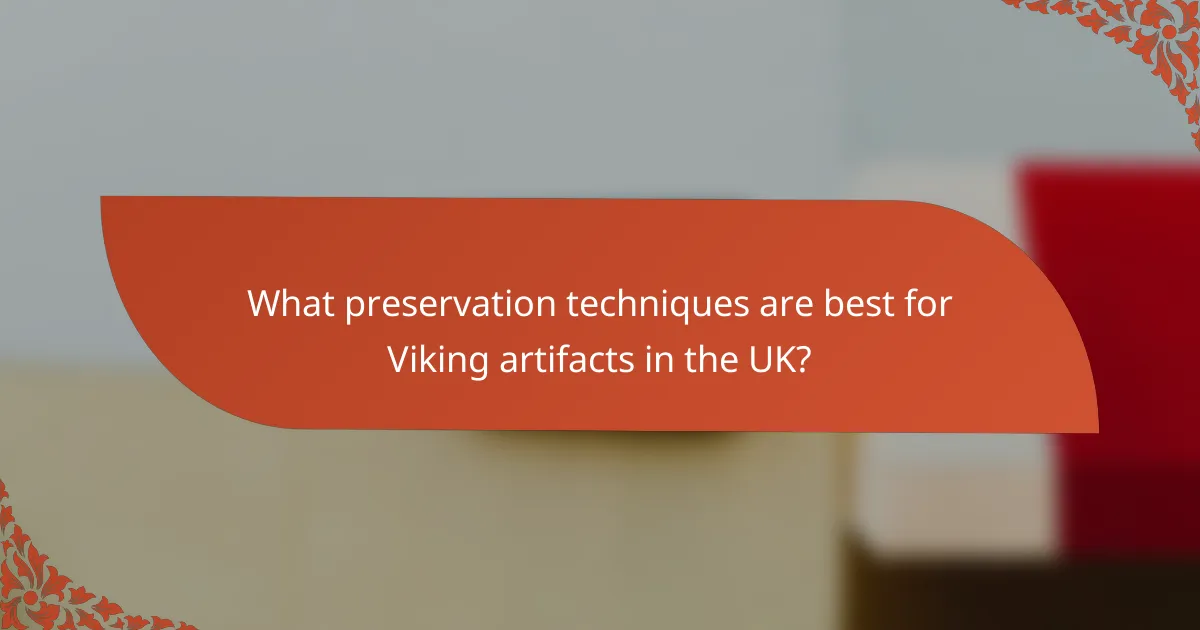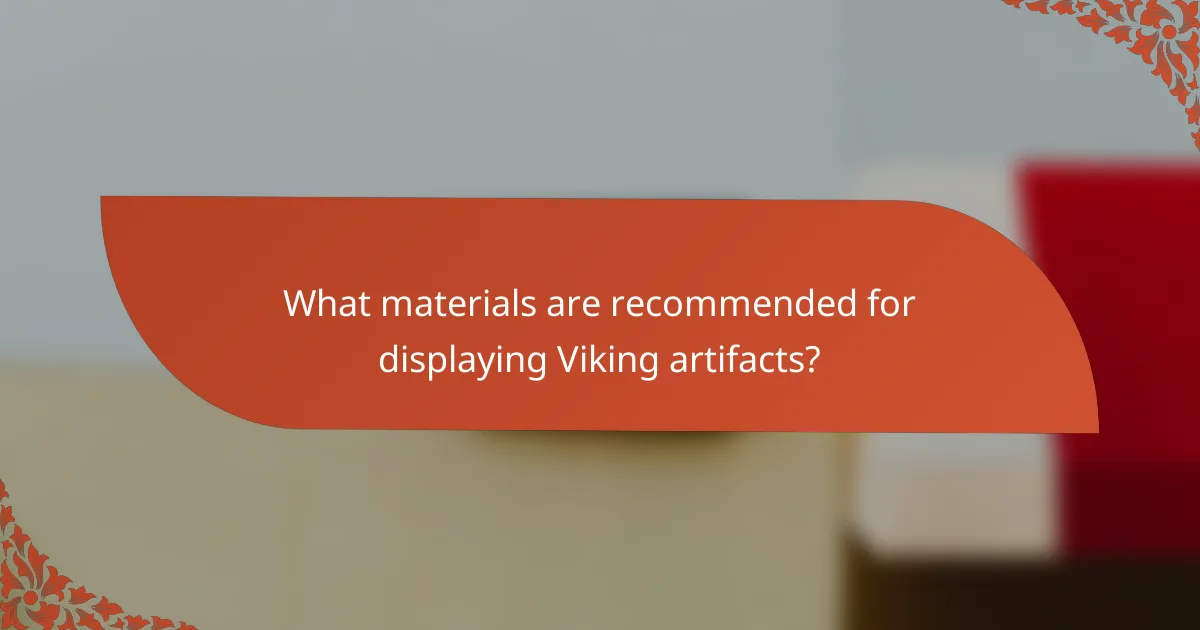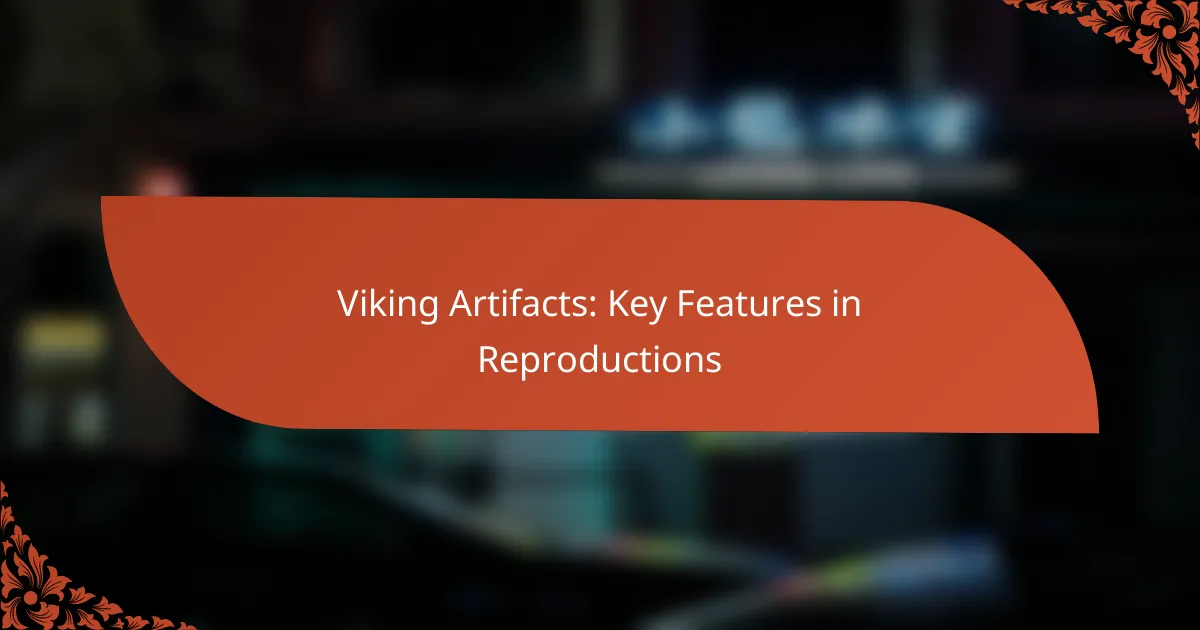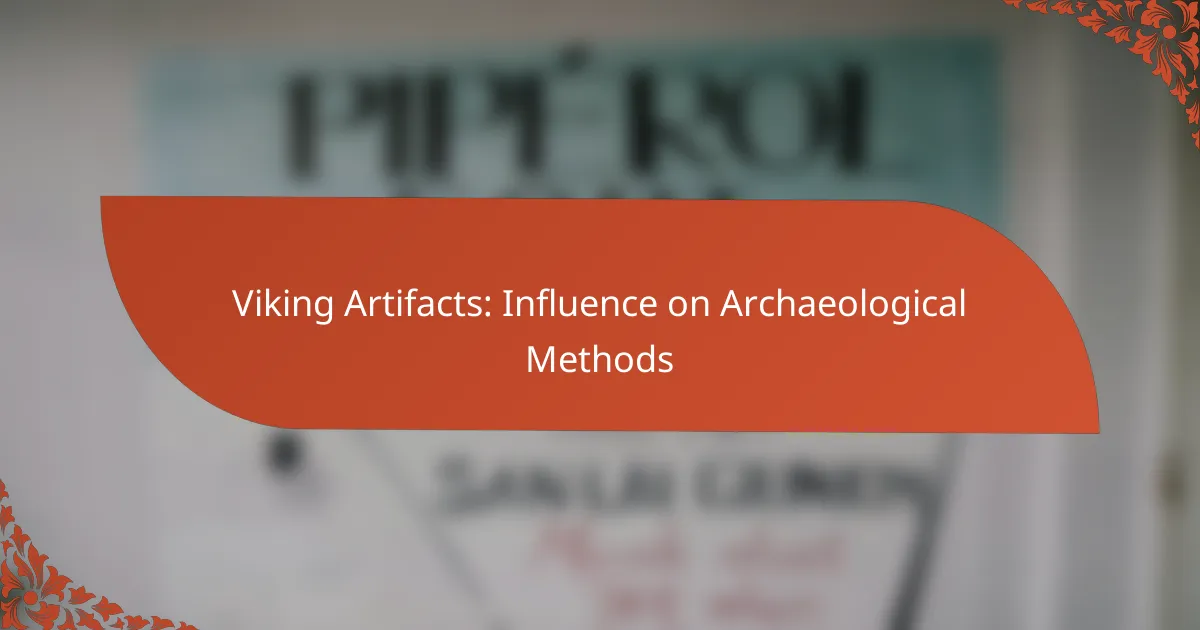Preserving Viking artifacts at home requires careful attention to environmental factors and cleaning techniques to maintain their historical integrity. Collectors should focus on controlling temperature and humidity, minimizing light exposure, and using inert materials for storage and display. Regular condition assessments and appropriate cleaning methods are essential to prevent deterioration and ensure these treasured items remain in excellent condition for future generations.

What preservation techniques are best for Viking artifacts in the UK?
To effectively preserve Viking artifacts in the UK, collectors should focus on controlling temperature, managing humidity, reducing light exposure, using inert materials, and conducting regular condition assessments. These techniques help prevent deterioration and maintain the integrity of these historical items.
Temperature control
Maintaining a stable temperature is crucial for preserving Viking artifacts. Ideally, the storage environment should be kept between 18°C and 22°C, avoiding extreme fluctuations that can cause materials to expand or contract. Sudden temperature changes can lead to cracks or other damage.
Use a reliable thermometer to monitor the temperature regularly. If necessary, consider using air conditioning or heating systems to maintain the desired range. Avoid placing artifacts near heat sources or in direct sunlight, as this can raise temperatures unexpectedly.
Humidity management
Humidity levels significantly impact the preservation of Viking artifacts. Aim for a relative humidity of around 40% to 60% to prevent mold growth and corrosion. High humidity can accelerate deterioration, while low humidity can lead to dryness and cracking.
Utilize dehumidifiers or humidifiers as needed to maintain the appropriate humidity levels. Regularly check humidity levels with a hygrometer, and consider using silica gel packets in storage areas to absorb excess moisture.
Light exposure reduction
Minimizing light exposure is essential for preserving Viking artifacts, as ultraviolet (UV) light can cause fading and degradation. Store items in dark or low-light environments whenever possible, and avoid direct sunlight exposure.
When displaying artifacts, use UV-filtering glass or acrylic cases to protect them from harmful light. Limit the duration of exposure to light, and consider rotating displayed items to reduce overall light exposure over time.
Use of inert materials
Using inert materials for storage and display is vital to avoid chemical reactions that can damage Viking artifacts. Choose acid-free boxes, tissue, and padding to prevent contamination and deterioration.
Avoid using materials like wood or cardboard that can emit harmful acids. Instead, opt for materials specifically designed for conservation purposes, ensuring they do not interact negatively with the artifacts.
Regular condition assessments
Conducting regular condition assessments helps identify any changes or deterioration in Viking artifacts. Schedule evaluations every six months to a year, checking for signs of damage, such as corrosion, mold, or structural issues.
Document the condition of each artifact during assessments, noting any changes over time. This practice allows for timely intervention and helps maintain the artifacts’ integrity for future generations.

How to clean Viking artifacts safely?
Cleaning Viking artifacts requires careful techniques to avoid damage. Using appropriate tools and solutions ensures the preservation of these historical items while maintaining their integrity.
Use of soft brushes
Soft brushes are essential for cleaning Viking artifacts without scratching or damaging the surface. Natural bristle brushes, such as those made from squirrel or camel hair, are ideal as they are gentle yet effective in removing dirt and debris.
When using a soft brush, work in a well-lit area and gently sweep away loose particles. Avoid applying excessive pressure, as this can harm delicate features or engravings on the artifacts.
Distilled water rinsing
Rinsing Viking artifacts with distilled water is a safe method to remove contaminants. Distilled water is free from minerals and chemicals that could react with the artifact’s material, making it a preferable choice.
To rinse, gently submerge the artifact in a bowl of distilled water or use a soft cloth dampened with the water. Ensure that the artifact is completely dry afterward to prevent moisture-related damage.
pH-neutral cleaning solutions
Using pH-neutral cleaning solutions is crucial for maintaining the integrity of Viking artifacts. These solutions do not alter the chemical composition of the materials, reducing the risk of corrosion or degradation.
Look for cleaning products specifically designed for archaeological artifacts or those labeled as pH-neutral. Always test a small, inconspicuous area first to ensure compatibility before applying it to the entire surface.

What materials are recommended for displaying Viking artifacts?
To effectively display Viking artifacts, use materials that prevent deterioration and enhance visibility. Recommended options include acid-free display cases, UV-filtering glass, and non-reactive mounting materials to ensure the longevity and integrity of these historical items.
Acid-free display cases
Acid-free display cases are essential for protecting Viking artifacts from environmental damage. These cases are made from materials that do not emit harmful acids, which can lead to corrosion or degradation over time. When selecting a display case, ensure it is labeled as acid-free and made from archival-quality materials.
Consider the size and shape of your artifacts when choosing a display case. Custom options may be necessary for larger or uniquely shaped items. Regularly check the interior for dust and moisture, as these can also harm your artifacts.
UV-filtering glass
UV-filtering glass is crucial for protecting Viking artifacts from harmful ultraviolet light, which can cause fading and deterioration. This type of glass blocks a significant percentage of UV rays while allowing visible light to pass through, ensuring your artifacts remain vibrant.
When purchasing UV-filtering glass, look for products that specify their UV protection level, ideally blocking over 90% of UV radiation. This investment can significantly extend the lifespan of your artifacts, making it a worthwhile consideration for collectors.
Non-reactive mounting materials
Using non-reactive mounting materials is vital to avoid chemical reactions that could damage Viking artifacts. Materials such as polyester film, cotton, and certain types of foam are ideal as they do not release harmful substances over time.
When mounting artifacts, ensure that the materials used do not come into direct contact with the items. Instead, use spacers or supports that keep the artifacts elevated and protected. Regularly inspect the mounting materials for signs of wear or degradation to maintain the integrity of your display.

What are the common mistakes in preserving Viking artifacts?
Common mistakes in preserving Viking artifacts include using improper cleaning methods, inadequate storage conditions, and neglecting professional advice. These errors can lead to irreversible damage, reducing the artifacts’ historical and monetary value.
Improper cleaning methods
Using harsh chemicals or abrasive tools can severely damage Viking artifacts. Instead, opt for gentle cleaning solutions, such as distilled water or mild soap, and soft brushes or cloths to remove dirt without scratching surfaces.
Always test any cleaning method on a small, inconspicuous area first. This precaution helps ensure that the cleaning process does not harm the artifact’s material or finish.
Inadequate storage conditions
Storing Viking artifacts in damp or poorly ventilated areas can lead to mold growth and corrosion. Maintain a stable environment with low humidity levels, ideally between 30-50%, and store items in acid-free boxes or display cases.
Consider using silica gel packets to absorb moisture and prevent damage. Regularly check storage conditions to ensure they remain optimal for artifact preservation.
Neglecting professional advice
Failing to seek professional advice can result in costly mistakes when preserving Viking artifacts. Consult with conservators or experts who specialize in historical artifacts to understand the best practices for care and maintenance.
Joining collector groups or forums can also provide valuable insights and recommendations. Engaging with the community allows collectors to share experiences and learn from one another’s successes and challenges.

What tools do collectors need for artifact preservation?
Collectors need specific tools to effectively preserve Viking artifacts, focusing on maintaining optimal environmental conditions and careful handling. Essential tools include microfiber cloths, digital hygrometers, and temperature monitors to ensure artifacts remain in good condition.
Microfiber cloths
Microfiber cloths are crucial for cleaning artifacts without causing scratches or damage. They are designed to trap dust and dirt while being gentle on surfaces, making them ideal for delicate materials often found in Viking artifacts.
When using microfiber cloths, avoid using them when they are wet or dirty, as this can lead to scratches. Instead, use a clean, dry cloth for routine dusting and maintenance.
Digital hygrometers
Digital hygrometers measure humidity levels, which is vital for preserving artifacts. Maintaining humidity between 40% and 60% helps prevent mold growth and material degradation.
Place the hygrometer in the display area or storage space to monitor conditions regularly. If humidity levels are too high, consider using a dehumidifier to maintain a stable environment.
Temperature monitors
Temperature monitors help ensure that artifacts are stored at appropriate temperatures, ideally between 18°C and 22°C (64°F to 72°F). Fluctuations outside this range can lead to material damage.
Use a digital thermometer to keep track of temperature changes, especially in areas with extreme weather. If temperatures rise significantly, consider relocating artifacts to a more stable environment to protect them from heat damage.

How to assess the condition of Viking artifacts?
Assessing the condition of Viking artifacts involves examining their physical state to determine preservation needs. This process includes identifying any signs of deterioration, damage, or environmental impact that could affect their integrity.
Visual inspections
Visual inspections are the first step in assessing the condition of Viking artifacts. Look for visible signs of wear, such as scratches, discoloration, or corrosion, which can indicate the artifact’s age and exposure to elements. Pay attention to any unusual markings or changes in texture that may suggest previous restoration efforts.
During a visual inspection, consider the material composition of the artifact. For example, metal artifacts may show rust or patina, while organic materials like wood or leather may exhibit cracking or flaking. Use a magnifying glass for detailed examination, especially for smaller items.
To ensure a thorough inspection, create a checklist of common issues to look for, such as:
- Surface damage (scratches, dents)
- Color changes (fading, staining)
- Structural integrity (cracks, breaks)
- Signs of pests (insects, mold)
Document your findings with photographs and notes to track changes over time, which can help inform future preservation efforts.








